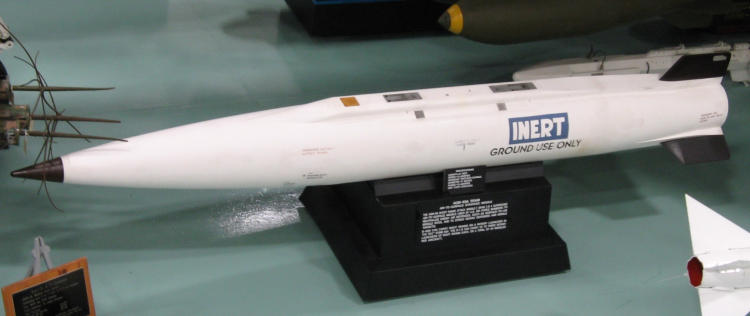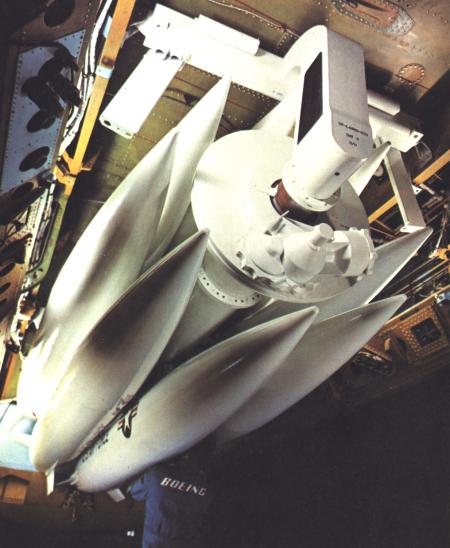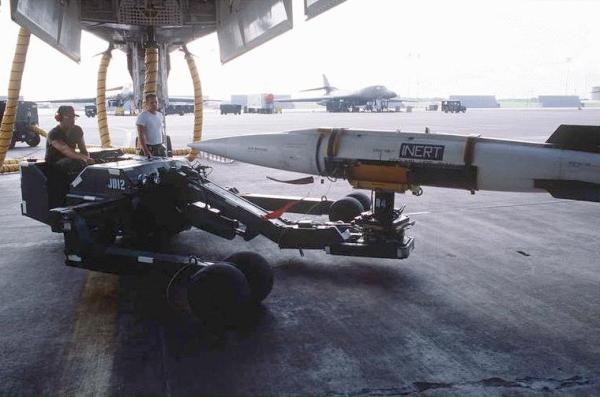Boeing AGM-69 SRAM
The SRAM (Short Range Attack Missile) was a relatively small standoff missile for use by USAF's B-52 and FB-111A strategic bombers. On the B-52, it replaced the AGM-28 Hound Dog.
After the cancellation of the GAM-87/AGM-48 Skybolt ALBM (Air-Launched Ballistic Missile) in December 1962, the USAF had to find another way to modernize the strike capabilities of its strategic bomber force. In March 1964, SOR (Specific Operational Requirement) 212 for a short-range attack missile was submitted by the USAF, and in March 1965, development was approved by the Department of Defense. SRAM was known as WS (Weapon System) 140A, and the missile designator ZAGM-69A was assigned. The following design competition was won by Boeing, who received a development contract for the SRAM in October 1966. The SRAM was to be used by the B-52, the FB-111A, and the then forthcoming AMSA (Advanced Manned Strategic Aircraft, later designated as B-1). The first powered flight of an AGM-69A occurred in July 1969, and in January 1971, full scale production of the SRAM was approved. In August 1972, the SRAM was operational with SAC units, and quickly replaced the AGM-28 Hound Dog as the B-52's standoff attack missile.
 |
| Photo: Greg Goebel |
| AGM-69A |
The AGM-69A was a ballistic-type air-to-ground missile powered by a Lockheed SR75-LP-1 two-pulse solid-fuel rocket motor, and armed with a 200 kT W-69 thermonuclear warhead. The first motor stage propelled the missile to Mach 3 after launch, and the second stage was ignited near the target for a powered terminal approach. Maximum range varied from 55 km (35 miles) for low-altitude launches to 160 km (100 miles) for high-altitude firings. The SRAM was guided by an General Precision/Kearfott KT-76 inertial navigation system, assisted by a Stewart-Warner terrain clearance sensor, and could achieve an accuracy of about 430 m (1400 ft) CEP. The B-52 Stratofortress could carry 8 SRAMs on a rotary launcher in the bomb bay, and up to 12 more on two external 6-missile pylons. The FB-111A could carry up to 6 SRAMs. When carried externally, an expendable tail faring was used on the missile to reduce drag. The AGM-69A greatly increased the number of targets which could be attacked by a single bomber, and made it possible to attack known (fixed) air-defense installations en route to the primary target.
 |
| Photo: Boeing |
| AGM-69A |
Several proposals were made to improve the versatility of the AGM-69A, including a radar guidance system to use it as an air-to-air missile, or an anti-radiation seeker to attack mobile air-defense radars, but none of these features were adopted. In the mid-1970s, however, storability problems with the rocket motor surfaced, and in 1976 Thiokol was awarded a contract to develop a new motor for SRAM. In 1977, the new motor was combined with other upgrades, including an improved guidance system (with enhanced computing capability) and the W-80 warhead of the AGM-86 ALCM. The new SRAM missile, designated AGM-69B SRAM B, was intended for use by the B-1A. In 1978, however, the B-1A was cancelled, and the USAF found a way to extend the lifespan of the old motor to the originally planned 5 years, and these two events killed the AGM-69B program. Instead, it was then planned to eventually replace the AGM-69A with the AGM-86 ALCM and the forthcoming ASALM (Advanced Strategic Air-Launched Missile). The latter, however, was also cancelled in 1980. When the B-1 program was resurrected (as B-1B) in 1981, it was decided to develop an entirely new weapon, later to be known as AGM-131 SRAM II.
 |
| Photo: USAF |
| AGM-69A |
In June 1990, the AGM-69A SRAM was retired from the USAF inventory. Various reasons have been quoted, including unreliability of the warhead and the rocket motor. The AGM-131 SRAM II was cancelled the following year, leaving effectively a gap in the capability of the USAF's B-52 bomber force. A total of about 1500 AGM-69A missiles were built by Boeing until production ended in 1975.
Specifications
Note: Data given by several sources show slight variations. Figures given below may therefore be inaccurate!
Data for AGM-69A:
| Length | 4.27 m (14 ft) (4.83 m (15 ft 10 in) with tail fairing) |
| Fin Halfspan | 38 cm (15 in) (fin tip to centerline) |
| Diameter | 45 cm (17.5 in) |
| Weight | 1010 kg (2230 lb) |
| Speed | Mach 3 |
| Range | 160 km (100 miles) |
| Propulsion | Lockheed Propulsion Co. SR75-LP-1 two-pulse solid-fueled rocket |
| Warhead | W-69 thermonuclear (200 kT) |
Main Sources
[1] James N. Gibson: "Nuclear Weapons of the United States", Schiffer Publishing Ltd, 1996
[2] Bill Gunston: "The Illustrated Encyclopedia of Rockets and Missiles", Salamander Books Ltd, 1979
[3] Christopher Chant: "World Encyclopaedia of Modern Air Weapons", Patrick Stephens Ltd., 1988
Back to Current Designations Of U.S. Unmanned Military Aerospace Vehicles
Back to
Directory of U.S. Military Rockets and Missiles
Last Updated: 13 May 2004